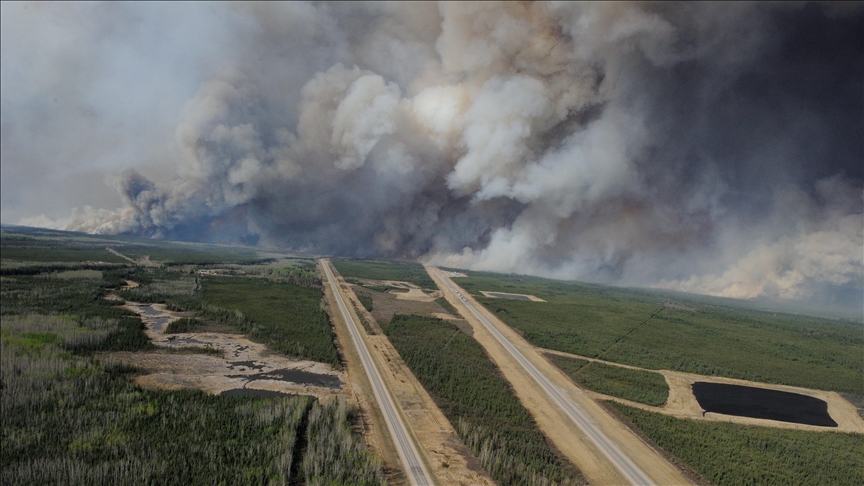Global Courant
Kyiv, Ukraine — Ukraine on Tuesday accused Russian forces of blowing up a major dam and hydroelectric power station in a part of southern Ukraine controlled by Russia, causing water to spill out of the breached facility and put it at risk of massive flooding. Ukrainian authorities ordered hundreds of thousands of residents to evacuate downstream.
Russian officials countered that the Kakhovka dam had been damaged by Ukrainian military strikes in the disputed area.
Ukrainian authorities have previously warned that the failure of the Kakhovka dam could release 18 million cubic meters (4.8 billion gallons) of water and flood Kherson and dozens of other areas downstream, where hundreds of thousands of people live. occupied nuclear power plant.
Ukrainian nuclear operator Energoatom said in a Telegram statement that blowing up the dam “could have negative consequences for the Zaporizhzhia nuclear power plant”, but at the moment the situation is “manageable”.
The UN’s International Atomic Energy Agency wrote on Twitter that its experts were closely monitoring the situation at the Zaporizhzhia Nuclear Power Plant upstream and that there was “no immediate risk to nuclear safety” at the facility.
According to the Ukraine War Environmental Consequences Working Group, a total collapse of the dam would wash away much of the left bank and a severe reservoir drop could rob the nuclear power plant of crucial cooling and dry up the water. supplies in northern Crimea.
President Volodymyr Zelenskyy called an emergency meeting to deal with the crisis, Ukrainian officials said.
The Ukrainian Interior Ministry wrote on Telegram that the Kakhovka dam had blown up and called on residents of 10 villages on the right bank of the river and parts of Kherson town downstream to collect essential documents and pets, turn off appliances and to leave. while warning of possible disinformation.
Russia-installed mayor of Nova Kakhovka, Vladimir Leontyev, said on Tuesday that numerous attacks on the Kakhovka hydroelectric plant destroyed its valves and that “water from the Kakhovka reservoir began to flow uncontrollably downstream.”
Leontyev said the attacks were “a very serious act of terrorism”, said Moscow-appointed authorities are “preparing for the worst consequences” – although they are not pushing for an evacuation of city residents.
Ukraine controls five of the six dams along the Dnipro, which runs from the northern border with Belarus to the Black Sea and is crucial for the entire country’s drinking water and power supply.
Images from what appeared to be a surveillance camera overlooking the dam that circulated on social media claimed to show a flash, explosion and rupture of the dam.
Oleksandr Prokudin, the head of Kherson’s regional military administration, said in a video posted to Telegram shortly before 7 a.m. that “the Russian army has committed another act of terror,” warning that water could reach “critical levels” within five hours. will reach. .
Energoatom wrote that the Kakhovka reservoir, where the water level is “decreasing rapidly,” is necessary “for the plant to feed the turbine condensers and ZNPP safety systems,” the statement said.
“Currently, the station’s cooling pond is full: as of 8 a.m., the water level is at 16.6 meters, which is enough for the station’s needs,” it said.
Energoatom will continue to monitor the situation with the IAEA, the statement said.
Ukraine and Russia have previously accused each other of attacks on the dam, and last October Zelenskyy predicted that Russia would destroy the dam to cause a flood.
Authorities, experts and residents have been expressing concern for months about the water flows through and over the Kakhovka dam.
In February, water levels were so low that many feared a meltdown at the Zaporizhzhia Nuclear Power Plant, whose cooling systems are supplied with water from the Kakhovka reservoir held back by the dam.
In mid-May, after heavy rains and melting snow, water levels rose above normal levels, flooding nearby villages. Satellite images showed water washing over damaged lock gates.
Ukraine controls five of the six dams along the Dnipro River, which runs from the northern border with Belarus to the Black Sea and is crucial for the entire country’s drinking water and power supply. The Kakhovka dam – the most downstream – is controlled by Russian troops.








